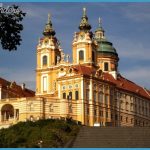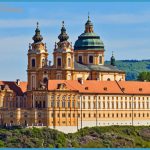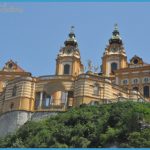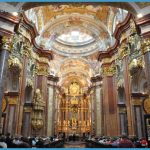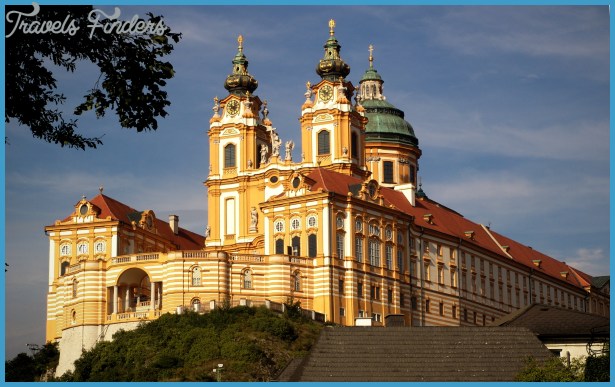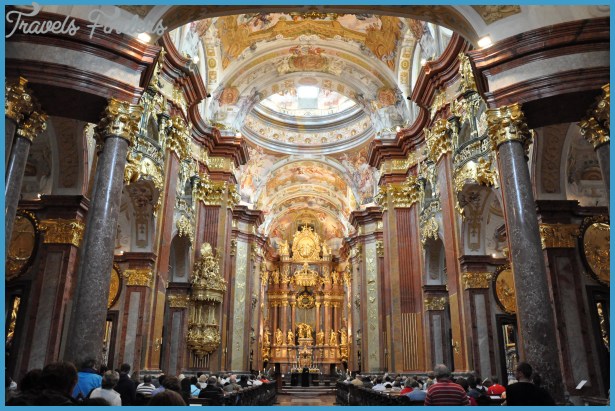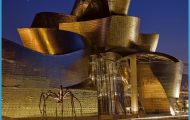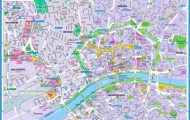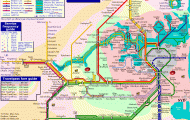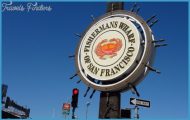JAKOB PRANDTAUER
From its elevated position on a rocky outcrop the great Benedictine abbey of Melk towers over the Danube in Lower Austria. Founded in the 11th century, it became renowned as a center of faith and learning, but by 1700 its buildings were no longer fit for the purpose, and the dynamic abbot, Berthold Dietmayr, commissioned the architect Jakob Prandtauer to redesign it. Prandtauer specialized in the baroque style, and he created a new church, accommodation, library, and other structures that transformed Melk into one of the largest and most elaborate baroque buildings in the world.
Baroque architecture developed in Italy in the late 16th century, and by 1700 it had spread across Catholic Europe. The style is characterized by a dramatic use of light and space, curving walls, ornate domes, decoration using painting, sculpture, and stucco (plaster rendering), and a fondness for illusionistic, trompeoeil effects. In Catholic countries the Baroque, with its scope for large-scale religious imagery, came to be synonymous with the renewal of the Church after the Reformation and explains why monasteries such as Melk embraced it so enthusiastically.
The abbey church at Melk stands at the heart of the complex, its large dome and towers topped with cupolas that dominate the skyline. The surrounding buildings are lower, yet palatial in style, with the living quarters, state apartments, large library, and school arranged around several courtyards. Their impressive scale and decoration are reminders that the abbey’s inhabitants expected a high standard of comfort and convenience. Even from a distance, many features establish the abbey as baroque-the intricately shaped cupolas, curving gables, and the use of colored stucco all combine to make this one of the world’s most impressive religious buildings.
JAKOB PRANDTAUER c. 1660-1726
Born at Stanz in the Tirol, Jakob Prandtauer began his working life as a stonemason, learning the craft from his father. He also worked as a sculptor before becoming a master builder, which gave him the responsibility for the design as well the construction of his buildings. He worked at first in Sankt Polten, near Vienna, before becoming involved with the reconstruction of several important Austrian monasteries and churches. These included the monasteries of St. Florian, near Linz, the abbey at Garsten, near Steyr, and the pilgrimage church on the Sonntagberg. He acted both as architect and builder, supervising the construction and overseeing the work of painters, decorators, and sculptors. He became well-versed in the baroque style and was ideally suited to take on the rebuilding of the monastery at Melk, a project that occupied him from 1702. Much of his work remained unfinished at his death, but his cousin and assistant Josef Mungenast completed his projects.
Visual tour
2 WEST FRONT Laid out in the style of a medieval cathedral, the west front of the church features twin towers above a central doorway. The details, however, are quite different. There are cupolas instead of spires on the tops of the towers, and the front is broken up with classical pilasters (vertical protrusions) and cornices. There are fewer statues than on most medieval church fronts, but they are much larger and include a group on the skyline, which is a typical baroque touch.
3 CHURCH INTERIOR This is the most stunning interior in the whole monastery, with natural light falling from high windows to illuminate a wealth of gilded details on everything from the pulpit canopy to the statues behind the high altar. In the nave the side walls curve gently, dipping in and out past arches leading to side chapels. The line of the curving cornice (the darkest detail in this bright interior) leads the eye toward the dome and the vaulted sanctuary beyond.
1 FACADE DETAIL The clock towers show Prandtauer’s handling of baroque motifs, which feature very few right-angles or straight lines. The moldings and cornices curve one way and another to create a sense of movement. Their flowing lines are echoed in the outlines of the scrolls on each corner and in the curvaceous molding around the clock face. The urns are another baroque touch, adding an extra layer of decoration and also breaking up the skyline. Prandtauer emphasized these effects with his use of color, picking out the moldings in terra-cotta against the white of the walls.
4 COURTYARD The courtyards are lined with rectangular windows topped with curving moldings, picked out with darker stucco than the surrounding walls. The pattern of windows creates an impression similar to the grandiose palace courtyards in many Central European cities. In the center of the paved quadrangle a baroque fountain is supported on sculpted figures. The replacement seen here was brought from a monastery at Waldhausen, Upper Austria, when Berthold Dietmayr gave the original to the town of Melk.
4 MARBLE HALL The Rule of St. Benedict, by which monks of the order lived, instructed them to receive guests as if they were Christ and accord them due honor. This magnificent room was intended as a dining hall fit for guests of the highest social rank, including members of the ruling Hapsburg dynasty, who often visited Melk. The main door surrounds are made of marble, but the walls are decorated with stucco painted to look like marble. In the center of the floor is an iron grating, beneath which a heater brings warm air into the room, making it as comfortable as it is grand. The ceiling has a huge painting showing scenes from classical mythology, including one of the hero Hercules killing the hound of hell with his club. Hercules was seen as a virtuous figure and was a favorite of the Hapsburgs.
1 DOME INTERIOR The dome forms the church’s spatial center, and light from its windows helps illuminate the rich decoration. The painting is a trompe l’oeil depiction of the heavens and, like the others in the church, it was probably designed by Italian-Austrian artist Antonio Beduzzi and painted by Austrian baroque master Johann Michael Rottmayr. God the Father, Jesus Christ, and, in the lantern, the dove representing the Holy Spirit are all depicted.
ON DESIGN
Baroque churches can seem rather crowded with decorative details. Window surrounds, cornices, niches, and other architectural features are adorned with ornamental scrolls or shells, or populated with statues of saints or small angels (cherubim and seraphim) often portrayed as winged children. Important fixtures and fittings, such as the reredos (the screen behind the altar), the pulpit, and the organ are singled out for special attention, with statues of saints or reliefs showing biblical scenes.
1 Organ
Gilded statues of cherubim sit above the organ pipes at the west end of the nave in the church at Melk.
ON DETAIL
Baroque artists aimed to dissolve the rigid lines and rectangular interiors of previous architecture by means of curving walls and hidden windows. Decorative ceilings, which often featured religious or mythological figures, reinforced this effect. Painted in the trompe l’oeil style, the ceilings created the illusion that the room was open to the skies, and that the figures in the painting were looking down at the world below them. Painters such as Rottmayr, who created the ceiling frescoes in the church at Melk, became adept at perspective, foreshortening the figures so that they seemed to float in mid-air. The artist sometimes added architectural details around the edge so that the walls of the building seemed to extend upward, and employed specialists, such as Gaetano Fanti from Italy, to paint these elements.
1 Ceiling figures
The ceiling artists who worked at Melk adjusted the perspective of their paintings carefully, enlarging feet and limbs that were closer to the viewer.

